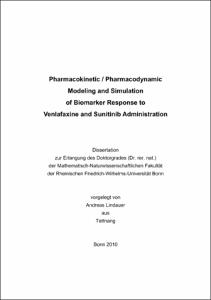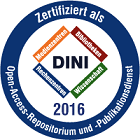Lindauer, Andreas: Pharmacokinetic / Pharmacodynamic Modeling and Simulation of Biomarker Response to Venlafaxine and Sunitinib Administration. - Bonn, 2011. - Dissertation, Rheinische Friedrich-Wilhelms-Universität Bonn.
Online-Ausgabe in bonndoc: https://nbn-resolving.org/urn:nbn:de:hbz:5N-24565
Online-Ausgabe in bonndoc: https://nbn-resolving.org/urn:nbn:de:hbz:5N-24565
@phdthesis{handle:20.500.11811/4950,
urn: https://nbn-resolving.org/urn:nbn:de:hbz:5N-24565,
author = {{Andreas Lindauer}},
title = {Pharmacokinetic / Pharmacodynamic Modeling and Simulation of Biomarker Response to Venlafaxine and Sunitinib Administration},
school = {Rheinische Friedrich-Wilhelms-Universität Bonn},
year = 2011,
month = mar,
note = {In this thesis the concept of pharmacokinetic/pharmacodynamic modeling using biomarkers for the description of concentration-effect relationships was illustrated on the example of two projects with drugs from different therapeutic areas.
As first example venlafaxine, an antidepressant selectively inhibiting serotonin and norepinephrine reuptake from the synaptic gap, was investigated. The inhibition of norepinephrine uptake is assumed to enhance antidepressant efficacy when venlafaxine is given at higher therapeutic doses.
In a randomized-controlled crossover trial, 12 healthy volunteers received placebo or venlafaxine for 14 days. Blood samples were drawn to determine serum concentrations of venlafaxine and its major active metabolite.Together with data from serial pupillographic measurements in these volunteers, a pharmacokinetic/pharmacodynamic (PK/PD) model was developed to describe the time course of the noradrenergic response.
A rapid development of tolerance of the pupillary light reflex parameters, amplitude and 33% recovery time, was seen, most probably due to desensitization of beta-adrenoceptors.
As examples of possible applications of the model, optimal pupillographic sampling times for a hypothetical single-dose study were calculated based on the modeling results. Using simulations it was investigated how an oral formulation with a slower drug release (extended release) would influence the PD response-time profile.
In the second project sunitinib, a multitargeted tyrosine kinase inhibitor with antiangiogenic properties, was investigated. The effects on blood pressure, plasma concentrations of vascular endothelial growth factor A and C (VEGF-A and -C) and its soluble receptor-2 (sVEGFR-2) in response to administration of sunitinib were studied in 12 healthy volunteers. PK/PD models were developed to quantify changes of these biomarkers in relation to plasma concentrations of sunitinib and its active metabolite.
Increasing blood pressure and VEGF-A levels were observed shortly after the first dose while a decrease in sVEGFR-2 occurred with substantial delay. No concentration-dependent changes of VEGF-C levels were observed in this study. Simulated blood pressure-time courses excellently compared to published patient data, whereas changes in circulating biomarkers were greater in patients than simulations suggested for healthy subjects. With the model for blood pressure changes, and published models for survival and incidence of fatigue, clinical trials were simulated showing that blood pressure-guided dose individualization could potentially prolong the median survival time by 210 days, compared to the standard dosing regimen.
The approach of PK/PD modeling and simulation using biomarkers was successfully applied in both projects and more insight into the concentration-response relationship of venlafaxine and sunitinib was obtained. Biomarkers will play an increasingly important role in drug development and pharmacotherapy. They will guide important decisions regarding candidate selection, dose finding and regulatory approval and will improve our understanding of complex diseases like cancer and mental disorders. Modeling and simulation are extremely useful tools to fully exploit the potential of biomarkers in this context.},
url = {https://hdl.handle.net/20.500.11811/4950}
}
urn: https://nbn-resolving.org/urn:nbn:de:hbz:5N-24565,
author = {{Andreas Lindauer}},
title = {Pharmacokinetic / Pharmacodynamic Modeling and Simulation of Biomarker Response to Venlafaxine and Sunitinib Administration},
school = {Rheinische Friedrich-Wilhelms-Universität Bonn},
year = 2011,
month = mar,
note = {In this thesis the concept of pharmacokinetic/pharmacodynamic modeling using biomarkers for the description of concentration-effect relationships was illustrated on the example of two projects with drugs from different therapeutic areas.
As first example venlafaxine, an antidepressant selectively inhibiting serotonin and norepinephrine reuptake from the synaptic gap, was investigated. The inhibition of norepinephrine uptake is assumed to enhance antidepressant efficacy when venlafaxine is given at higher therapeutic doses.
In a randomized-controlled crossover trial, 12 healthy volunteers received placebo or venlafaxine for 14 days. Blood samples were drawn to determine serum concentrations of venlafaxine and its major active metabolite.Together with data from serial pupillographic measurements in these volunteers, a pharmacokinetic/pharmacodynamic (PK/PD) model was developed to describe the time course of the noradrenergic response.
A rapid development of tolerance of the pupillary light reflex parameters, amplitude and 33% recovery time, was seen, most probably due to desensitization of beta-adrenoceptors.
As examples of possible applications of the model, optimal pupillographic sampling times for a hypothetical single-dose study were calculated based on the modeling results. Using simulations it was investigated how an oral formulation with a slower drug release (extended release) would influence the PD response-time profile.
In the second project sunitinib, a multitargeted tyrosine kinase inhibitor with antiangiogenic properties, was investigated. The effects on blood pressure, plasma concentrations of vascular endothelial growth factor A and C (VEGF-A and -C) and its soluble receptor-2 (sVEGFR-2) in response to administration of sunitinib were studied in 12 healthy volunteers. PK/PD models were developed to quantify changes of these biomarkers in relation to plasma concentrations of sunitinib and its active metabolite.
Increasing blood pressure and VEGF-A levels were observed shortly after the first dose while a decrease in sVEGFR-2 occurred with substantial delay. No concentration-dependent changes of VEGF-C levels were observed in this study. Simulated blood pressure-time courses excellently compared to published patient data, whereas changes in circulating biomarkers were greater in patients than simulations suggested for healthy subjects. With the model for blood pressure changes, and published models for survival and incidence of fatigue, clinical trials were simulated showing that blood pressure-guided dose individualization could potentially prolong the median survival time by 210 days, compared to the standard dosing regimen.
The approach of PK/PD modeling and simulation using biomarkers was successfully applied in both projects and more insight into the concentration-response relationship of venlafaxine and sunitinib was obtained. Biomarkers will play an increasingly important role in drug development and pharmacotherapy. They will guide important decisions regarding candidate selection, dose finding and regulatory approval and will improve our understanding of complex diseases like cancer and mental disorders. Modeling and simulation are extremely useful tools to fully exploit the potential of biomarkers in this context.},
url = {https://hdl.handle.net/20.500.11811/4950}
}






